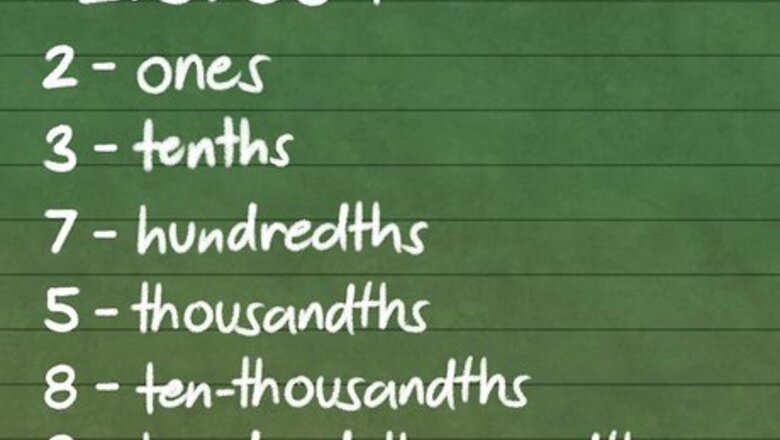
views
X
Research source
Rounding Instructions
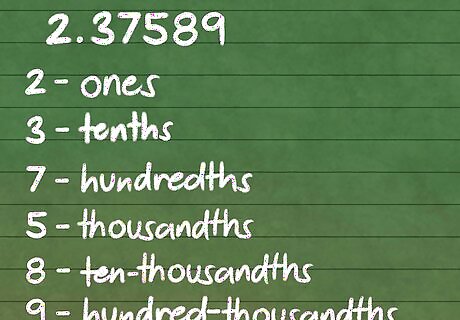
Understand the idea of decimal places. In any number, the different digits represent different amounts. For instance, in the number 1,872, the "1" represents thousands, the "8" represents hundreds, the "7" represents tens, and the "2" represents ones. When there is a decimal point in a number, the numbers to the right of the point represent fractions of one. The places to the right of the decimal point have names that mirror the names of the whole number decimal places. The first number to the right of the decimal point represents tenths, the second represents hundredths, the third represents thousandths, and so on for ten-thousandths, etc. For example, in the number 2.37589, "2" is the number of ones, "3" is the number of tenths, "7" is the number of hundredths, "5" is the number of thousandths, "8" is the number of ten-thousandths, and "9" is the number of hundred-thousandths.
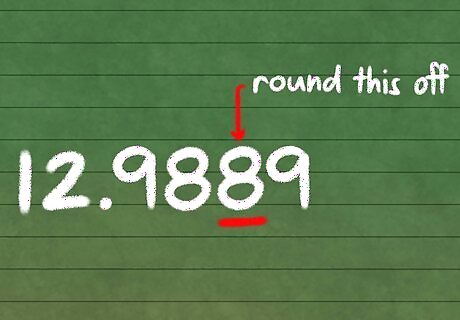
Find the decimal place you need to round to. The first step to rounding a decimal is to determine which decimal place you're going to round it to. If you're doing schoolwork, this information is usually given to you — often, the problem will say something like, "round the answer to the nearest tenth/hundredth/thousandth." For example, if you are asked to round to the nearest thousandth in the number 12.9889, you would start by finding the thousandths place. Counting from the decimal point, the spaces to the right represent tenths, hundredths, thousandths, and ten-thousandths, so the second "8" (12.9889) is the one you want. Sometimes, instructions will tell you exactly which decimal place to round to (e.g., "round to the third decimal place" means the same thing as "round to the nearest thousandth").
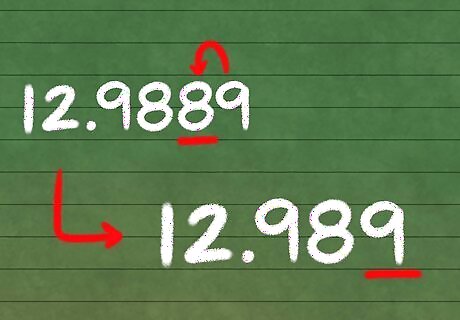
Look at the number in the space to the right. Now, find the decimal place to the right of the place you're rounding to. Based on the number in this place, you'll round either up or down. In our example number (12.9889), you're rounding to the thousandths place (12.9889), so now look at the number to the right of this, which is the final "9" (12.9889).
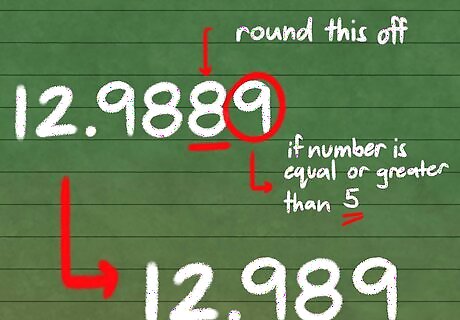
If this number is greater than or equal to five, round up. To be clear: if the place you're rounding to is followed by a 5, 6, 7, 8, or 9, round it up. In other words, make that decimal place one value greater and get rid of the digits after it. In the example number (12.9889), since the final 9 is higher than 5, round your thousandths place up. The rounded value becomes 12.989. Note that you drop the digits after the rounded decimal place.
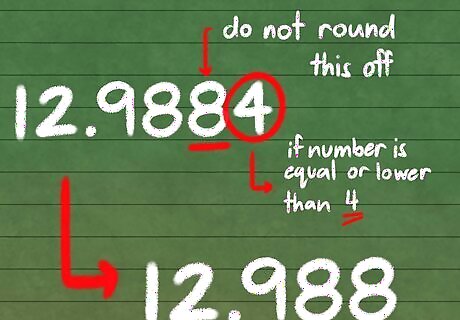
If this number is less than five, round down. On the other hand, if the place you're rounding to is followed by a 4, 3, 2, 1, or 0, round it down. This means to leave the rounded digit as it is and get rid of the digits after it. You wouldn't round 12.9889 down because the final 9 isn't 4 or lower. However, if you were working with the number 12.9884, you could round it down to 12.988. Does this process seem familiar? If so, it's because this is basically how you round whole numbers — the decimal point doesn't change things.
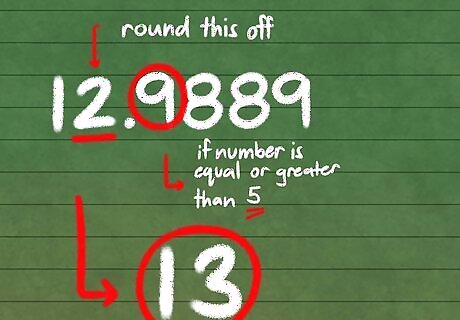
Use the same technique to round to a whole number. One common rounding task is to round a number to the nearest whole number (sometimes, this will be explained as "rounding the number to the ones place"). In this case, use the same rounding technique as before. In other words, start at the ones place, then look at the number to the right. If this number is 5 or greater, round up. If it is 4 or lower, round down. The decimal point in the middle doesn't change anything. For example, if you needed to round the example number from earlier (12.9889) to the nearest whole number, you'd start by looking at the ones place: 12.9889. Since the "9" to the right is greater than 5, you would round up to 13. Since you've gotten a whole number answer, you don't need the decimal point any more.
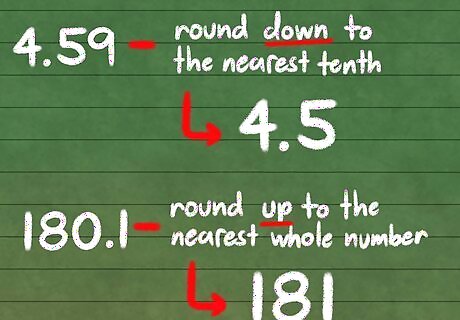
Look out for special instructions. The directions for rounding above will work well in general. However, when you've been given special directions for rounding decimal places, make sure to follow them before you use the normal rounding rules. For example, if you receive the instructions "Round 4.59 down to the nearest tenth", you'd round the 5 in the tenths place down even though the 9 to the right means you'd normally round it up. This would give you 4.5. Similarly, if you are told to "round 180.1 up to the nearest whole number," you'd round to 181 even though you'd normally round down.
Example Problems
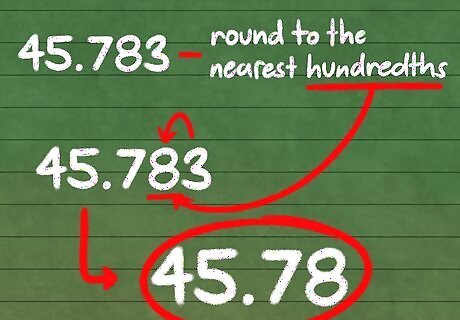
Round 45.783 to the nearest hundredth. See below for the solution. First, find the hundredths place. This is two spaces to the right of the decimal point, or 45.783. Then, look at the number to the right: 45.783 Since 3 is less than 5, round down. This gives an answer of 45.78.
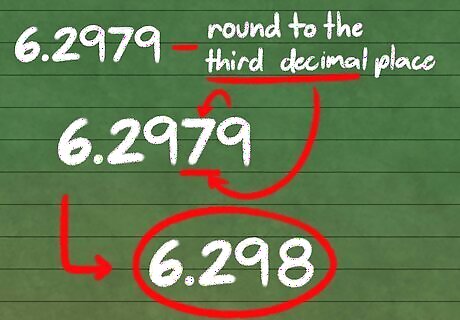
Round 6.2979 to the third decimal place. Remember that "third decimal place" means to count three spaces to the right of the decimal point. This is the same thing as saying "thousandths place." See below for the solution: Find the third decimal place. This is 6.2979. Look at the number to the right. This is 6.2979. Since 9 is greater than 5, round up. This gives an answer of 6.298.
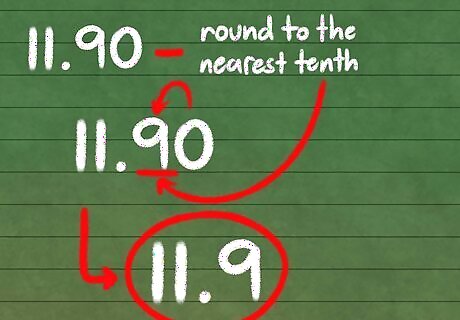
Round 11.90 to the nearest tenth. The "0" here makes this one a little tricky, but remember that zeroes count as numbers less than four. See below for the solution: Find the tenths place. This is 11.90. Look at the number to the right. This is 11.90. Since 0 is less than 5, round down. This gives an answer of 11.9.
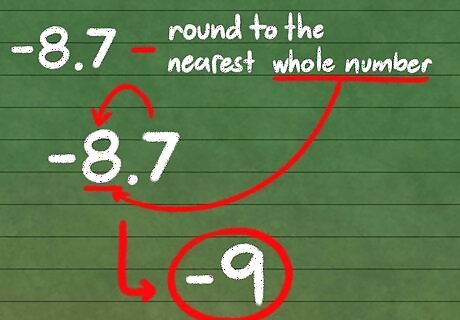
Round -8.7 to the nearest whole number. Don't be intimidated by the negative sign — rounding negative numbers works exactly the same way as rounding positive numbers. Find the ones place. This is -8.7 Look at the number to the right. This is -8.7. Since 7 is greater than 5, round up. This gives an answer of -9. Leave the negative sign as-is.




















Comments
0 comment